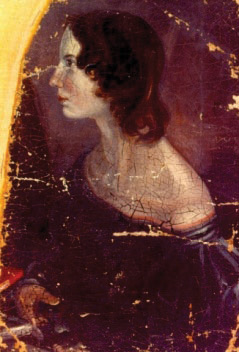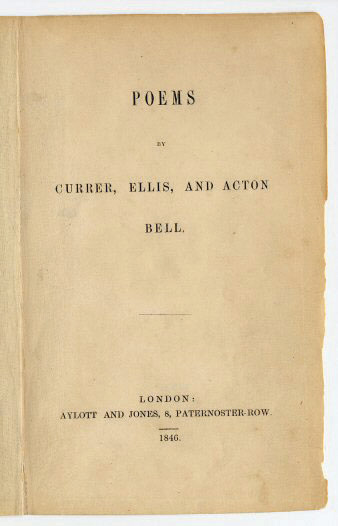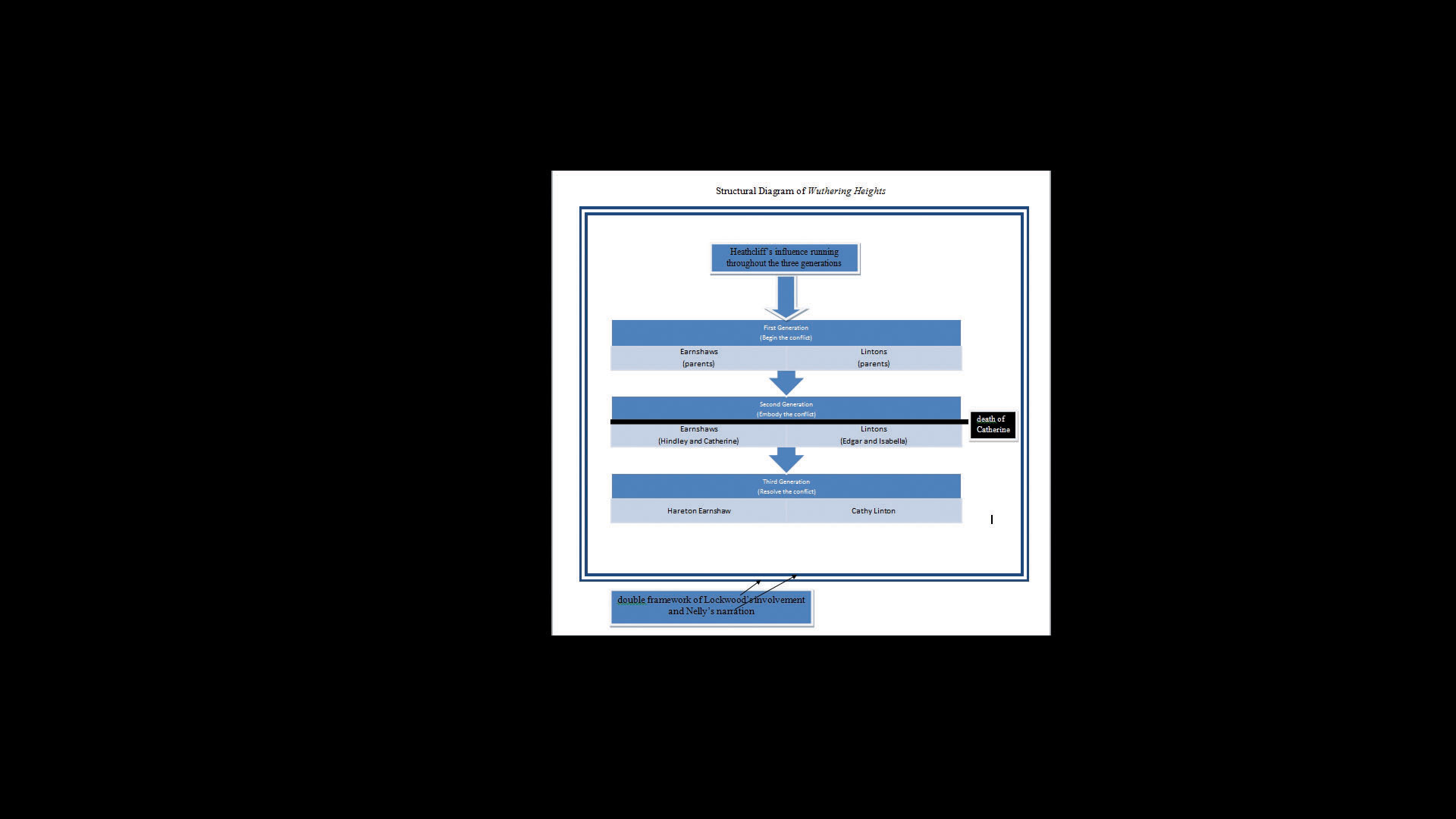This is “Emily Brontë (1818–1848)”, section 7.3 from the book British Literature Through History (v. 0.1). For details on it (including licensing), click here.
For more information on the source of this book, or why it is available for free, please see the project's home page. You can browse or download additional books there. To download a .zip file containing this book to use offline, simply click here.
7.3 Emily Brontë (1818–1848)
PLEASE NOTE: This book is currently in draft form; material is not final.

Learning Objectives
- List major characters, explain their roles in the plot, and analyze their characters within the novel and as they might be interpreted by both Victorian and contemporary audiences.
- Outline the chronology of the novel’s major events, and compare and correlate the chronology with the order in which events are presented in the novel.
- Assess the relationship between character and setting, and provide specific examples.
- Analyze the differences in relationships among the second generation and the third generation that allow the younger characters to resolve the novel’s conflicts.
Biography
The village of Haworth website offers virtual tours of the interior of the Brontë Parsonage Museum.
Text
- Wuthering Heights. Electronic Text Center, University of Virginia Library.
- Wuthering Heights by Emily Brontë. Project Gutenberg.
- Wuthering Heights and Agnes Grey. The Haworth Edition. New York and London. Harper & Brothers Publishers. 1900. Hathi Trust Digital Library.
Wuthering Heights (1846)
A novel, according to Holman and Harmon’s standard definition is an “extended fictional prose narrative.” A novel’s components include character, plot, structure, setting, and theme.

An 1846 edition of Poems showing the use of pen names, Currer, Ellis, and Acton Bell.

Emily Brontë’s drawing of herself and Anne writing at a table in the Bronté parsonage in Haworth. This sketch is on display in the Brontë Parsonage Museum in Haworth.
As in most novels, in Wuthering Heights character, plot, and structure are tightly interwoven; one element drives the others. Particularly significant in Wuthering Heights is setting, which Brontë uses to reflect character.
- Character: While contemporary audiences tend to read Wuthering Heights with a sympathetic view of Heathcliff and Catherine, Victorian audiences would have agreed that Edgar was the appropriate choice of a husband for Catherine. We may think that couples should follow their hearts, but a Victorian audience, particularly an upper or middle class audience, would have believed that Catherine had a duty to marry her social equal—Edgar. The conflict within Catherine as she feels torn between Heathcliff and Edgar is a focal point of the novel. Her death marks the transition between the two parts of the story. Of course, Wuthering Heights is largely Heathcliff’s story; his desire for revenge drives the plot.
- Plot: The main story is told as a flashbackThe insertion of an event from earlier in the natural chronology that interrupts the narrative., the insertion of an event from earlier in the natural chronology that interrupts the narrative. The story opens with the arrival of Lockwood at Wuthering Heights. After his nightmarish encounter with the apparition of Catherine, Nelly Dean begins to tell Lockwood the story of the Earnshaws and the Lintons. Most of the book, then, is her narration of events that have already happened. The final chapters return to the novel’s present, the time of Lockwood, as the conflicts are resolved.
- Structure: The structure of Wuthering Heights is built on the three generations of characters in the story: the older generation (who set in motion the conflicts); their children (who comprise the conflicts of the novel); and the youngest generation (who resolve the conflicts). Through these three layers of characters runs a connecting thread in the character of Heathcliff. Providing a framework for this structure are the narrations of Nelly and Lockwood.
- Setting: The characteristics of the two families, the Earnshaws and the Lintons, are reflected in their homes, Wuthering Heights and Thrushcross Grange. Even the weather is used to mirror the emotions of the characters.


A structural diagram of Wuthering Heights.
Video Clip 3
Emily Brontë and the Yorkshire Moors
(click to see video)View a video mini-lecture about Emily Bronte and the Yorkshire Moors.
Key Takeaways
- Heathcliff, the structurally central character of the novel, is a Byronic hero, generally sympathetic to modern audiences but generally unsympathetic to Victorian audiences.
- Wuthering Heights and Thrushcross Grange reflect the characters who live there, and conflict occurs when Catherine attempts to cross the social boundaries represented by the estates, boundaries well established for Victorian audiences.
- Setting, including the weather, reflects character.
- The third generation resolves the conflicts, in part by overcoming the social restrictions that bound their parents.
Exercises
Catherine
- How does Brontë depict Catherine’s attachment to Heathcliff when they were children? What character traits do Catherine and Heathcliff share that might have drawn them to each other? Identify specific events or specific character traits.
- How does Catherine change after her stay with the Lintons at Thrushcross Grange? How do the changes affect her relationship with Heathcliff?
- After Catherine’s stay with the Lintons, it becomes clear that she has developed a relationship with Edgar Linton. How would you describe that relationship? How does it affect her relationship with Heathcliff? What factors in society or in Catherine herself affect her feelings about each man?
- What reasons does Catherine give in her conversation with Nelly for deciding to marry Edgar? How does Nelly respond to her reasoning? During this conversation, Nelly is aware that Heathcliff is listening to part of the conversation although Catherine is not. How does Nelly’s decision not to tell Catherine affect the events of the novel? Why did Nelly make the decision not to reveal that Heathcliff was there?
- What does Catherine mean when she says, “I am Heathcliff”?
- Catherine is often described as having a dual personality or a split personality. She feels drawn in contradictory directions, torn between Edgar and Heathcliff. In fact, her death is attributed to this duality that she is unable to reconcile. What events bring about the crisis that results in her death?
- When Heathcliff returns after Catherine is married to Edgar, Catherine seems surprised that Nelly, Edgar, and society in general disapprove of her continuing her friendship with Heathcliff. Why would she expect to continue what society sees as an improper relationship? At the end of the novel, Catherine is buried between Edgar and Heathcliff wearing a locket that contains a lock of each man’s hair. How do you characterize Catherine’s relationship with the two men?
Heathcliff
- Emily Brontë’s sister Charlotte Brontë wrote a preface for the 1850 edition of Wuthering Heights in which she stated, “Whether it is right or advisable to create beings like Heathcliff, I do not know: I scarcely think it is.” Heathcliff is a Byronic anti-hero; in Victorian eyes he would be seen as an evil person without redeeming qualities, the opinion Charlotte Brontë expressed. Modern audiences might be more inclined to see Heathcliff as a product of his environment. What childhood events and relationships contribute to the warping of Heathcliff’s personality?
- When Nelly informs Heathcliff that Catherine has died, Heathcliff cries out for Catherine to “haunt” him. What evidence indicates that she does, figuratively or literally?
- When Hindley dies, Heathcliff determines to bring up Hareton himself at Wuthering Heights. He comments to Hareton, “Now, my bonny lad, you are mine! And we’ll see if one tree won’t grow as crooked as another, with the same wind to twist it!” What does Heathcliff mean? What does this comment reveal about Heathcliff’s character?
- What incident when Hareton was small indicates that Heathcliff may have some concern for him?
- Describe Heathcliff’s treatment of his wife Isabella and his son Linton.
- Near the end of the novel, Heathcliff’s desire for revenge seems to burn itself out. What causes this change, and what incidents illustrate his decreasing interest in life?
The Younger Generation
- Describe young Cathy when Lockwood first meets her. Describe her relationship with Hareton and the reasons for it.
- Describe Hareton as he appears when Lockwood first meets him. How has his life been similar to Heathcliff’s? Although he has experienced some of the same difficulties, he has not become hardened, or even evil, like Heathcliff; why? Do internal characteristics or outside influences temper his character?
- Although Linton is a pathetic character, he is not entirely sympathetic. How would you describe him? How would you account for his selfish, petty behavior?
- Describe Cathy and Hareton when Lockwood meets them again at the end of the novel. What has caused the change? How is that change reflected in the physical description of Wuthering Heights?
- How would you compare Cathy and Hareton with Catherine and Heathcliff?
The Settings
- Describe Wuthering Heights as it appears at the beginning of the novel. How is the description different at the end of the novel?
- How does weather function to reveal character? Consider the snowstorm at the beginning of the story, the storm the night Heathcliff leaves, and the weather at the end of the novel.
- How do the settings of the moors and the valley function to reveal character?
- Compare Wuthering Heights and Thrushcross Grange. How do the two estates reflect the characters who live there?
Resources
General Information
- “The Brontës.” The Brontë Parsonage Museum & Brontë Society.
- “Emily Brontë (1818–48).” The Victorian Web. links to biographical and critical information.
- “’Haworth, November 1904’ by Virginia Woolf.” Mary Mark Ockerbloom, ed. A Celebration of Women Writers.
- “Love on the Moors: The Bronte Family.” Sublime Anxiety: The Gothic Family and The Outsider. University of Virginia.
- “Overview of Emily Brontë.” Emily Brontë. Lilia Melani, Brooklyn College, City University of New York.
- “The Romantic Novel, Romanticism, and Wuthering Heights.” Lilia Melani, Brooklyn College, City University of New York.
Biography
- “Emily Jane Brontë.” The Brontë Parsonage Museum & Brontë Society.
- “Emily Jane Brontë: Poet and Novelist (1818–48).” The Victorian Web. Philip V. Allingham, Lakehead University.
Text
- Wuthering Heights. Electronic Text Center, University of Virginia Library.
- Wuthering Heights by Emily Brontë. Project Gutenberg.
- Wuthering Heights and Agnes Grey. The Haworth Edition. New York and London. Harper & Brothers Publishers. 1900. Hathi Trust Digital Library.
Audio
- Wuthering Heights. Learn Out Loud.com.
- Wuthering Heights. LibriVox.
Video
- Emily Bronte. Dr. Carol Lowe, McLennan Community College.
- Emily Bronte and the Yorkshire Moors. Dr. Carol Lowe, McLennan Community College.
Concordance
- “A Hyper-Concordance to the Works of the Brontë Sisters.” The Victorian Literary Studies Archive. Prof. Mitsu Matsuoka, Nagoya University.




